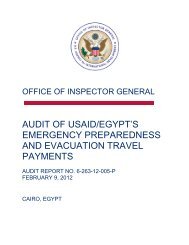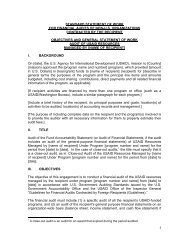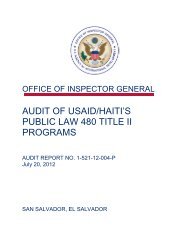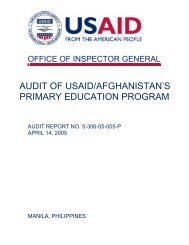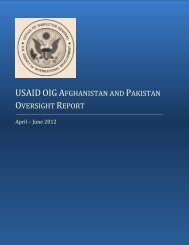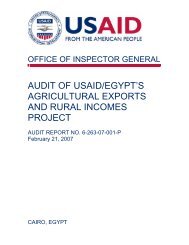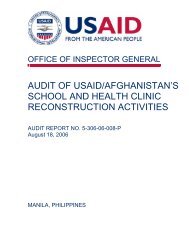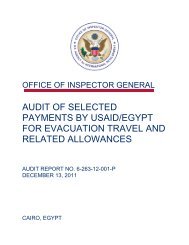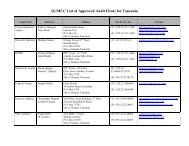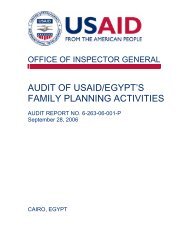Audit of USAID's Haiti Recovery Initiative Activities MAnaged by ...
Audit of USAID's Haiti Recovery Initiative Activities MAnaged by ...
Audit of USAID's Haiti Recovery Initiative Activities MAnaged by ...
You also want an ePaper? Increase the reach of your titles
YUMPU automatically turns print PDFs into web optimized ePapers that Google loves.
SCOPE AND METHODOLOGYScopeAppendix IRIG/San Salvador conducted this performance audit in accordance with generally acceptedgovernment auditing standards. Those standards require that we plan and perform the audit toobtain sufficient, appropriate evidence to provide a reasonable basis for our findings andconclusions in accordance with our audit objective. We believe that the evidence obtainedprovides that reasonable basis.The purpose <strong>of</strong> the audit was to determine whether OTI is achieving its main goals <strong>of</strong> stabilizing<strong>Haiti</strong> through support for community revitalization, increased citizen engagement, and improvedgovernance.OTI awarded a cost-plus-fixed-fee completion form task order to Chemonics on March 14, 2011,to provide short-term technical assistance to reinforce stability and lay the groundwork forlonger-term development in <strong>Haiti</strong>. As <strong>of</strong> May 3, 2012, OTI had obligated $46.5 million anddisbursed $23 million. As <strong>of</strong> February 10, 2012, OTI had approved activities worth$22.9 million.The audit was performed at USAID/<strong>Haiti</strong> and at the Chemonics project <strong>of</strong>fices in Port-au-Prince,Cap-<strong>Haiti</strong>en, and Saint-Marc from January 11 through April 11, 2012. The audit reviewed ajudgmental sample <strong>of</strong> 22 ongoing and completed activities valued at $6.8 million from a universe<strong>of</strong> 141 activities approved, in process, or completed as <strong>of</strong> February 2012, valued at$22.9 million. The audit covered the period March 14, 2011, through February 10, 2012. Wevisited 19 sites in Port-au-Prince, Cap-<strong>Haiti</strong>en, and Saint-Marc.In planning and performing the audit, we assessed relevant internal controls that OTI used tomanage its <strong>Haiti</strong> program. These controls included established policies and procedures forgrant administration and program management, monitoring and evaluation processes, andreporting processes.MethodologyTo answer the audit objective, we interviewed OTI and USAID/<strong>Haiti</strong> <strong>of</strong>ficials, Chemonicsemployees, grantees, and beneficiaries. We reviewed and analyzed relevant documentsincluding activity plans, grant agreements, grant and procurement documentation, activityprogress and final evaluation reports, and environmental reviews. We judgmentally selected22 ongoing and completed activities to obtain a sample <strong>of</strong> activities across regions, sectors,goals supported, and grantee type. We compared expected results with actual results <strong>by</strong>reviewing supporting documentation, observing activity implementation on site visits, andinterviewing grantees and beneficiaries. Since the testing was based on a judgmental sampleinstead <strong>of</strong> a statistical one, the results and conclusions are limited to the items tested and couldnot be projected to the entire audit universe.To determine the reliability <strong>of</strong> computer-processed data in OTI’s activity database, for activitiesreviewed we compared grant data to source documents, and compared reported progress withconditions we observed during site visits.12



